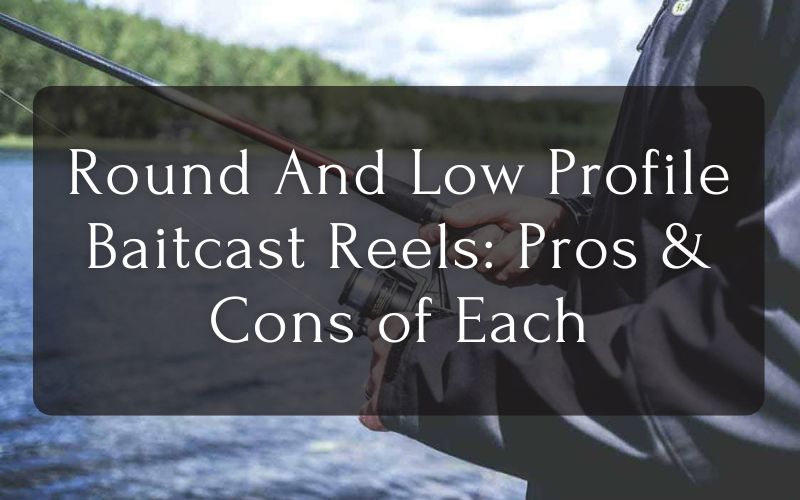Baitcasting reels are an essential aspect of any angler’s tackle. An angler can capture just about anything that swims in freshwater or saltwater with the appropriate reel. Round and Low profile baitcasting reels are the two most common types of reels used by baitcasters.
If you’re confused about how baitcasting reels work, determining which one is appropriate for a certain purpose can be difficult. You can follow the thorough guide that I’ve put together below before purchasing a baitcasting reel to make it easier.
This article will explain the differences between round and Low profile baitcasting reels and their benefits, drawbacks, and applications. So you can pick the proper one for your next fishing trip.
What Is A Round Baitcaster Reel?
As an angler, I know how important it is to have a reel to handle any situation. Round baitcasting reels have stronger drags than low-profile ones and are designed for larger fish. This makes them ideal for particular conditions, such as casting deep crankbaits or fishing heavier baits. Anglers understand the benefits of finding the appropriate gear to capture bigger fish on their next trip out!
For crappie and bass fishing, these reels could be a decent choice.
Pros Of Round Baitcast Reels
- First, they feature a much larger structure than low-profile baitcaster reels, allowing them to hold far more lines. Because of the stronger structure of these reels, you will be able to manage heavier lines. When fighting difficult-to-catch fish, experienced anglers choose stronger lines because the fishing line is less likely to break in these conditions.
- Likewise, their drag system is usually incredible, giving much power.
- You may troll huge lures, throw heavy baits with these reels, and achieve optimum casting distances.
- They provide more versatility than low-profile. They are capable of both finesse and heavy fishing jobs, making them suitable for people who enjoy various types of fishing.
- The mechanics of round reels differ from those of typical low-profile reels. The spool is larger due to a spherical construction, so it collects more lines each time you spin the handle for faster retrieval. It will be the better choice if you want to save time when reeling in fish.
- Larger, heavier lures work well with those reels.
- The greater spool weight can reduce Baitcaster backlash.
Cons Of Round Baitcast Reels
- Many individuals believe that palming the round reel is more difficult, and they are correct. Round reels are frequently uncomfortable after long periods of use. Because of the size of round reels, it’s difficult for those who have smaller hands and palms to handle them without suffering pain or soreness after a long time of use. However, if your palms are larger than usual, this will not be an issue because your hand will be able to hold most of the reel.
- A long spool and handle will take up extra space in your backpack. But it’s not a big issue.
Related post: Best Round Baitcaster You Shouldn’t Miss
What Is A Low Profile Baitcast Reel?
Low-profile baitcasting reels have two sides: one for the handle and one for the palm. These reels are built to fit comfortably in your hand. A palm side that contours to your hand when casting or retrieving line, and an ergonomic grip that fits comfortably in the palms of any size hand. This will be positioned where the reel meets your palm if it has a brake system.
If you look on any tackle website, you’ll find thousands of low-profile baitcasting reel designs, each with perks and features. However, you need to also think about gear ratio, weight, and casting restrictions.
Fish species such as pike, muskie, salmon, and steelhead benefit from this sort of fishing reel. So they can be suitable for both saltwater and freshwater fishing.
Pros Of Low Profile Baitcast Reels
- One of the key advantages of the low-profile baitcasting reel over the competition is its palm-side design, which fits naturally into the contours of the average hand in optimal comfort. Even a tiny person can acquire a stronger grip with this reel.
- Lightweight rods provide more control and a lighter feel on the rod for a Baitcaster.
- If you’re fishing on the other side of your boat, it’s simple to operate with just one hand.
- For lighter fishing, this is a decent option.
- It’s easier to store on a boat or at home.
- Smaller lures won’t get tangled up behind the larger vessel, ideal for trolling.
- They’re also a great choice for close-quarters fishing. This is because your casting distance does not need to be great in these scenarios, but you should be able to cast regularly. Again, this is doable with a low-profile baitcaster with a user-friendly and comfortable reel, allowing for frequent casting.
Cons Of Low Profile Baitcast Reels
- Low-profile baitcasting reels have a small design, which is their main disadvantage. As a result, unlike baitcaster reels with a spherical construction, they cannot retain as much line. The sizes start with 100, usually the smallest available on the market. They can, however, reach a maximum of 400.
- If you intend to do any heavy line spooling or casting great distances, they will not be the best choice. So keep it in mind before you make your choice.
Round And Low Profile Baitcasting Reels. Which One To Choose?
The design, line capacity, and strength are the key differences between a round baitcaster and a low-profile baitcaster. When deciding which form of equipment meets your needs, consider numerous aspects, such as the type of outside conditions or the species of fish you’ll be targeting. Low-profile baitcasting reels, for example, are commonly used by persons who engage in lightweight fishing. For heavier fishing, people are more likely to use a baitcasting reel with a round design than a spinning reel. However, the distinction is insignificant.

